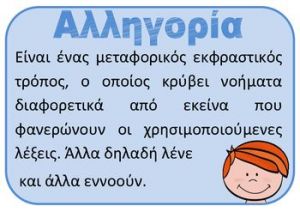Language/Modern-greek-1453/Culture/Allegory-in-Art-and-Literature
Allegory: Definition in Conversation and Literature[edit | edit source]
Allegory is an art form, whether it is an image or a story that gives us meaning through the use of symbols. Many people would consider allegory to be an extended type of metaphor. When used as a form of figurative language, allegory is useful in motivational speeches, informational speeches, or oral lessons because it is used to convey meaning in a way that is more comprehensible and easier to understand.
The word allegory (plural allegories) derives from ancient Greek: "Allegory-ες" and is translated as "to imply something" and this translation helps us to better understand its function. Literary allegories usually describe situations and events or express abstract ideas in terms of material objects, people and actions. Allegory, encompasses fable, parable and apologue forms. It has a meaning at two or more levels and the reader can only understand through a process of interpretation. Literary allegories usually describe situations and events or abstract ideas in terms of material objects, people and actions.
Writers such as Plato, Cicero, and Augustine used allegory, but it became particularly popular in sustained narratives of the Middle Ages. The most influential allegory of this period is the 13th century French didactic poem “Roman de la rose”: Romance de la Rose. The poem exemplifies the allegorical technique of personification, in which a fictional character represents a concept or type.
Symbolic allegory, which can range from a simple fable to a complex multilayered narrative, has often been used to represent political and historical situations and has long been popular as a vehicle for satire. Allegory may involve an interpretative process separate from the creative process; that is, the term allegory can refer to a specific method of reading a text, in which characters and narrative or descriptive details are taken by the reader as an elaborate metaphor for something outside of the literal story.
Straightforward Allegories[edit | edit source]
The Dutch master Hieronymus Bosch The Nave of Fools, painted his “Nave of Fools” around 1500 (Oil on wood. Paris, France, Louvre). Here, the ship is the vehicle, which represents the content of the nation-state; the owl (the vehicle) represents wisdom or circumspection (the tenor). But is this the only meaning that this painting can have? Not really! The ship of fools could also be our own minds, and all the people doing stupid things in it describe how each person is actually a mass of ungovernable, insane desires. (By Tekla Bude)
Plato's Allegory of the Cave[edit | edit source]
Plato's Allegory of the Cave, is an allegory presented by the Greek philosopher Plato in his book Republic to compare "the effect of education (παιδεία) and its absence on our nature". It's like a dialogue between Plato's brother Glaucon and his mentor Socrates, told by the latter. The allegory is presented after the analogy of the sun and the analogy of the divided line.
"The Cave", Socrates describes a group of people who lived chained to the wall of a cave all their lives, facing a blind wall. People look at shadows cast on the wall by objects passing in front of a fire behind them and give names to these shadows. The shadows are the reality of the prisoners, but are not exact representations of the real world.
The shadows represent the fragment of reality that we can normally perceive through our senses, while the objects under the sun represent the true forms of objects that we can only perceive through reason. Three higher levels exist: the natural sciences; mathematics, geometry and deductive logic; and the theory of forms.
- Note: The only exception is the music. There is no allegorical interpretation.
Author[edit source]
- Ευγενική χορηγία που στοχεύει να βοηθήσει μαθητές ή μη, απανταχού της Γης, που επιδίδονται στην εκμάθηση της ελληνικής γλώσσας!
- Contribution bénévole visant à aider les personnes, partout dans le monde, qui sont engagées dans l'apprentissage de la langue grecque !
- Voluntary contribution aimed at helping people, all over the world, who are committed to learning the Greek language!
Sources[edit | edit source]
Other Lessons[edit | edit source]
- The Ancient Olympic Games
- Historical speech of Xenophon Zolotas
- Best Greek Street Food
- épopée Homérique Odyssée
- Poetry
- Glass half full or half empty
- Dolmadakia
- Agnodice: The First Female Physician
- Baklavas: traditional Greek dessert
- Hetaira

